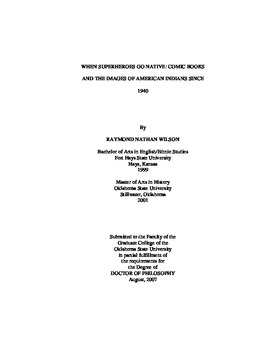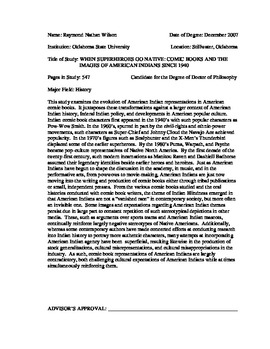| dc.description.abstract | This study examines the evolution of American Indian representations in American comic books. It juxtaposes these transformations against a larger context of American Indian history, federal Indian policy, and developments in American popular culture. Indian comic book characters first appeared in the 1940's with such popular characters as Pow-Wow Smith. In the 1960's, spurred in part by the civil-rights and ethnic-power movements, such characters as Super-Chief and Johnny Cloud the Navajo Ace achieved popularity. In the 1970's figures such as Scalphunter and the X-Men's Thunderbird displaced some of the earlier superheroes. By the 1980's Puma, Warpath, and Psyche became pop-culture representatives of Native North America. By the first decade of the twenty-first century, such modern incarnations as Manitou Raven and Dashiell Badhorse assumed their legendary identities beside earlier heroes and heroines. Just as American Indians have begun to shape the discussion in the academy, in music, and in the performative arts, from powwows to movie-making, American Indians are just now moving into the writing and production of comic books either through tribal publications or small, independent presses. From the various comic books studied and the oral histories conducted with comic book writers, the theme of Indian Blindness emerged in that American Indians are not a "vanished race" in contemporary society, but more often an invisible one. Some images and expectations regarding American Indian themes persist due in large part to constant repetition of such stereotypical depictions in other media. These, such as arguments over sports teams and American Indian mascots, continually reinforce largely negative stereotypes of Native Americans. Additionally, whereas some contemporary authors have made concerted efforts at conducting research into Indian history to portray more authentic characters, many attempts at incorporating American Indian agency have been superficial, resulting likewise in the production of stock generalizations, cultural misrepresentations, and cultural misappropriations in the industry. As such, comic book representations of American Indians are largely contradictory, both challenging cultural expectations of American Indians while at times simultaneously reinforcing them. | |

